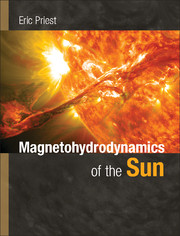Book contents
- Frontmatter
- Dedication
- Contents
- Preface
- 1 A Description of the Sun
- 2 The Basic Equations of Magnetohydrodynamics (MHD)
- 3 Magnetohydrostatics
- 4 Waves
- 5 Shock Waves
- 6 Magnetic Reconnection
- 7 Instability
- 8 Dynamo Theory
- 9 Magnetoconvection and Sunspots
- 10 Heating of the Upper Atmosphere
- 11 Prominences
- 12 Solar Flares and Coronal Mass Ejections
- 13 The Solar Wind
- Appendix 1 Units
- Appendix 2 Useful Values and Expressions
- References
- Index
4 - Waves
Published online by Cambridge University Press: 05 June 2014
- Frontmatter
- Dedication
- Contents
- Preface
- 1 A Description of the Sun
- 2 The Basic Equations of Magnetohydrodynamics (MHD)
- 3 Magnetohydrostatics
- 4 Waves
- 5 Shock Waves
- 6 Magnetic Reconnection
- 7 Instability
- 8 Dynamo Theory
- 9 Magnetoconvection and Sunspots
- 10 Heating of the Upper Atmosphere
- 11 Prominences
- 12 Solar Flares and Coronal Mass Ejections
- 13 The Solar Wind
- Appendix 1 Units
- Appendix 2 Useful Values and Expressions
- References
- Index
Summary
Introduction
Fundamental Modes
In a gas such as the air one breathes, one is aware of the continual presence of sound (or acoustic) waves – especially when there are children in the vicinity, willing to act as a source! Sound waves exist because of the presence of a pressure restoring force, so that a local compression or rarefaction of the gas sets up a pressure gradient in opposition to the motion, which tries to restore the original equilibrium. If the gas is uniform, the waves propagate equally in all directions at the sound speed cs. The main role of the waves is to carry energy away from the source, but, for the most part, they possess such a small amplitude that the ambient gas is disturbed only slightly. When its amplitude is large enough, however, a wave may sometimes steepen into a shock wave (Chapter 5), as with the sonic boom from a supersonic aircraft.
In a plasma such as that found in the solar atmosphere, there are typically four wave modes, driven by different restoring forces. The magnetic tension and Coriolis forces can drive so-called Alfvén waves and inertial waves, respectively. The magnetic pressure, plasma pressure and gravity can act separately and generate compressional Alfvén waves, sound waves and (internal) gravity waves, respectively; however, when acting together, these three forces produce only two magnetoacoustic gravity modes.
- Type
- Chapter
- Information
- Magnetohydrodynamics of the Sun , pp. 144 - 176Publisher: Cambridge University PressPrint publication year: 2014



